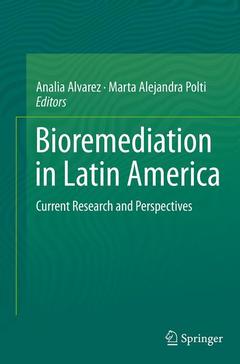Description
Bioremediation in Latin America, Softcover reprint of the original 1st ed. 2014
Current Research and Perspectives
Coordinators: Alvarez Analía, Polti Marta Alejandra
Language: English
Subjects for Bioremediation in Latin America:
Publication date: 08-2016
Support: Print on demand
Publication date: 10-2014
308 p. · 15.5x23.5 cm · Hardback
Description
/li>Contents
/li>Biography
/li>Comment
/li>
Dr. ALVAREZ, ANALÍA Pilot Plant of Industrial and Microbiological Processes (PROIMI) 1; National Council of Scientific and Technical Research (CONICET) 2; National University of Tucuman (UNT) 3 Tucuman, in Argentina.
Dr. POLTI, MARTA ALEJANDRA Pilot Plant of Industrial and Microbiological Processes (PROIMI) 1; National Council of Scientific and Technical Research (CONICET) 2; National University of Tucuman (UNT) 3 Tucuman, in Argentina.




